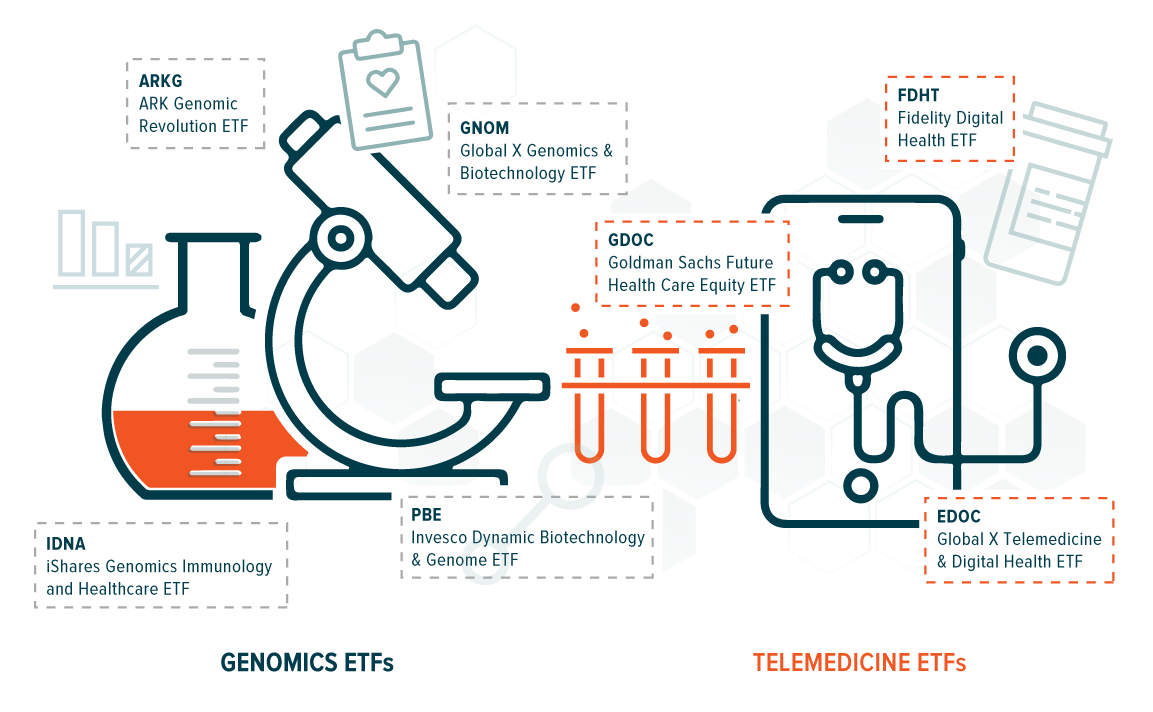Thematic Investing Whitepaper: Healthcare Innovation (Genomics & Telemedicine)
This piece is part of a larger whitepaper, Investing in Thematics From a PM Perspective.
From 1950 to 2022, global average life expectancy increased from 46.5 years to 71 years, and it is expected to rise to about 82 by 2100.1 By 2050, the global population of adults 60+ could double to more than 2 billion.2 It is clear humans are living longer than in any previous period in history. In less than 10 years, there will likely be more people over 65 years old than under 18 in the United States. This demographic shift has governments spending more on healthcare than ever before. The Congressional Budget Office (CBO) estimates that U.S. Government spending on healthcare will rise from 5.4% of GDP in 2017 to 6.8% by 2028 and 8.4% by 2040.3 In our view, the Healthcare Innovation investment theme, spurred by continued advances in genomics and telemedicine, is primed to benefit and create new opportunities for investors.
Key Takeaways
- An aging population increases demand for advanced and affordable healthcare, creating long-term investment opportunities.
- Genomics can provide real-time diagnosis in cheaper, faster, and more accessible ways.
- Telemedicine is growing rapidly, expanding access to affordable, virtual healthcare.
Why Healthcare Innovation is Such a Powerful Force
Rapidly falling costs for genomic sequencing drive utilization
The human genome has about 3 billion base pairs that make up 25,000 genes, and these genes create 23 large DNA sequences, or chromosomes. The sequence of base pairs is virtually identical in every human, but the subtle differences are what make us unique.4 These differences can translate to simple attributes like the color of someone’s eyes or hair, or more complex attributes like disorders, hereditary diseases, and disease resistance.
Genomics helps scientists explore and understand the intricate details of our DNA. By studying genomes, they can unlock valuable insights about our genetic variations and how our bodies work at a molecular level. Genomic sequencing increases understanding of disease inheritance, how disease is transmitted, and how to work towards a cure. Using genomics to diagnose diseases early, even before symptoms present themselves, can increase chances of successful treatments.5
The growth potential of this industry is significant, particularly as the cost per genome sequence declines. The cost of sequencing a genome fell substantially from an eye-popping $100 million per genome in 2002 to less than $600 in 2022 due to advances in sequencing technology.6 Prices are forecasted to fall to $200 per genome while doubling the speed of sequencing with the proliferation with advanced technologies, notably next-generation sequencing (NGS).7
NGS is a process that extracts a sample DNA, fragments it into pieces, and attaches those pieces to small readers that are inserted into a sequencing machine. Specialized software can then identify genetic variants, gene expression patterns, and other features of interest in each piece. NGS has led to genetically targeted drugs, blood tests for early cancer detection, and diagnoses for individuals with rare diseases. The technology is now used regularly to sequence the genomes of unborn children to identify any mutations, deletions, or additions to their genetic makeups.
The genomic sequencing market is expected to surpass $24.5 billion by 2030, growing at a compound annual growth rate (CAGR) of 16.1% from 2022 to 2030.8
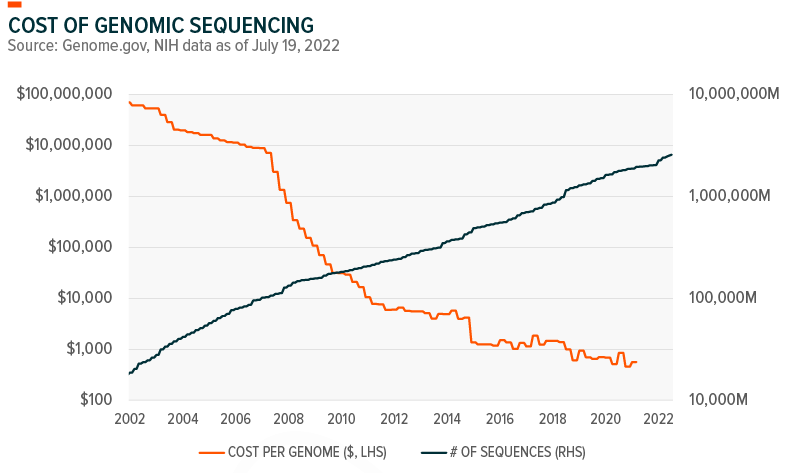
Empowering precision medicine, disease prevention & targeted therapies
The advancement of the Genomics theme allows for novel medical approaches to treat disease through precision medicine or prevent disease by correcting the underlying genetic problem through genetic therapies. Also, individuals can be proactive with their health and well-being instead of reactive. For example, the advent of direct-to-consumer genetic testing and other affordable healthcare technologies puts more accurate diagnoses, more effective treatments, and a better understanding of their own health risks in the hands of patients.
Pharmacogenomics uses an individual’s genetic profile to guide the treatment of a disease by creating personalized, or precision, medicine.9 With the ability to tailor treatments to individual patients based on their genes, healthcare providers and pharmaceutical companies can create more effective therapies with fewer side effects. The global personalized medicine market size is expected to increase by a CAGR of 6.93%, to $923 billion, by 2030 as demand for novel therapies and drugs increases.10
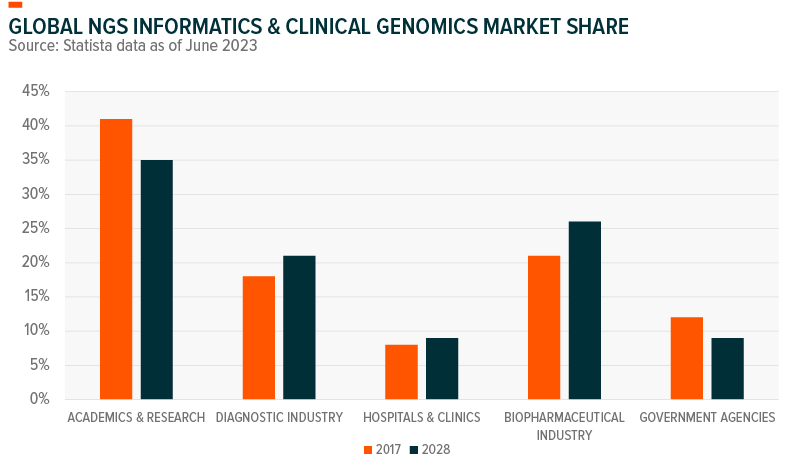
Genetic therapies aim to treat or cure diseases by correcting the underlying problem in an individual’s DNA. Genome editing can remove a stretch of DNA that causes a disease, turn off genes that make harmful proteins, turn on genes that make needed proteins, and correct a mutated gene.11 As it becomes ubiquitous, gene therapy has the potential to treat a wide range of diseases such as cancer, cystic fibrosis, heart disease, diabetes, hemophilia, and HIV.
Telemedicine expands patient care
With telemedicine, the push of a button connects doctors and patients virtually, bridging the gap between facility-based treatment and at-home care. Some telehealth companies are expanding offerings that drive value, such as pharmacy delivery services and in-home lab testing. Improvements in screening adherence, disease prevention, early diagnosis, and care management could be welcomed by insurance companies and government health programs that bear the cost of negative patient outcomes.
Among the many efforts at the federal level to advance U.S. telehealth services is the Consolidated Appropriations Act of 2023, which extended telehealth flexibilities after the COVID-19 emergency.12 With this bill, patients retain telehealth benefits, including for mental health.
Telemedicine is especially useful for elderly patients who are less mobile or patients in remote areas. The percentage of adults who used telemedicine in 2021 increased with age, from 29% among those aged 18–29 to 43% among those aged 65 and over, according to a survey by the National Center for Health Statistics.13 The use of helpers such as home healthcare aids, family, and volunteers rises as patients age, which could create another gateway for telemedicine.
Visualizing the Market Opportunity
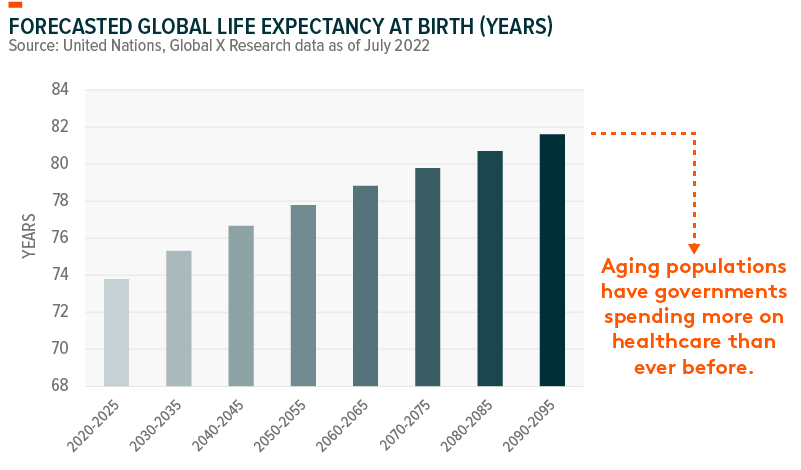
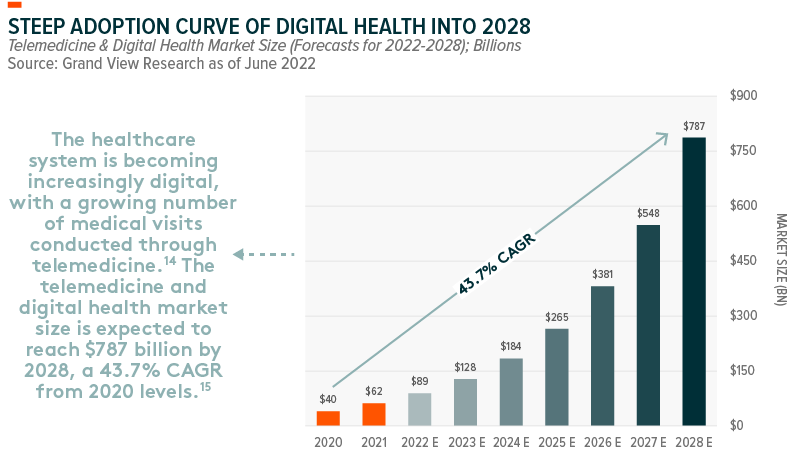
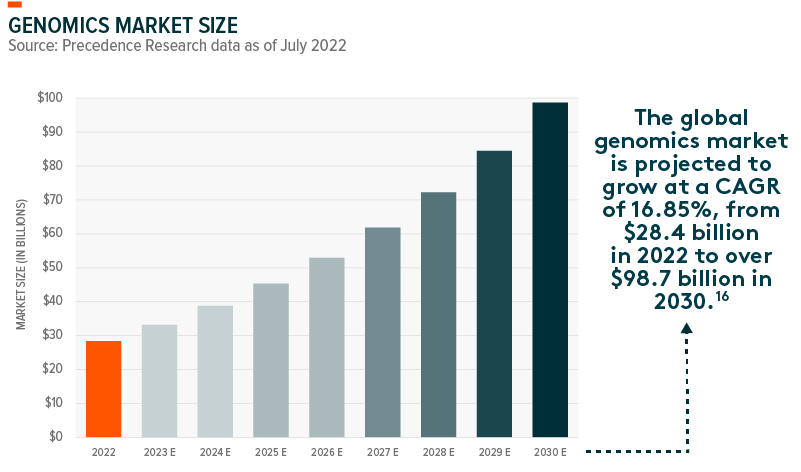
Risks to the Health Innovation Theme
Genomics price squeeze
Although it costs about $600 to sequence a genome, clinical interpretation, storage, genetic counseling, and clinical follow ups can drive the total price to a few thousand dollars for patients, and insurance doesn’t always cover all costs. Costs can also rise if testing for single genes instead of an entire genome. This is because single gene testing requires extensive manipulation of the DNA to isolate the target gene and provide a precise result.17 All costs considered; researchers may benefit more from inexpensive sequencing than patients.
Difficult interpretation of genomics results
Despite progress in this field, the lack of standardization in testing and interpretation of results is a risk to the development of genomics. Without standardization and oversight, different labs can interpret the same results differently, which could lead to incorrect diagnoses and treatments.18 Better quality control measures and standardized guidelines are needed to ensure accuracy and consistency across different testing platforms. Additionally, labs will be able to reduce costs further if a standard framework is created, since then they wouldn’t each need to incur the costs of developing their own standards.
Regulatory pressures and impact on pricing
The U.S. Inflation Reduction Act of 2022 includes a prescription cost-cutting plan, which could have long-term negative impacts on biopharma revenues. The law requires the federal government to negotiate prices for some drugs covered under Medicare plans beginning in 2026.19 Lower drug prices could have a modest impact on new drugs coming to market. The Congressional Budget Office expects a 1% reduction in new drugs over the next 30 years because of negotiated pricing.20 However, drug manufacturers may respond by increasing launch prices for future drugs, thereby setting negotiations at a higher price level, especially when there are no therapeutic alternatives available.
Difficult funding environment for healthcare startups
Debt financing could become increasingly difficult for biotech companies in a higher interest rate environment. Companies leveraged record low interest rates to raise startup capital, fund growth projects, and allocate to research and development. Venture capital firms invested a record $36.6 billion in biopharma companies in the United States, United Kingdom, and European Union in 2021.21 In 2022, private investment declined 19%, to $29.5 billion, as recessionary concerns weakened near-term growth prospects.22 If companies burn through cash, innovative projects could stall as companies prioritize immediate funding needs over long-term growth. The challenging funding environment could also lead to more acquisitions, potentially reducing pure play exposure to Healthcare Innovation.
Thematic Intersection with Healthcare Innovation
Use of artificial intelligence in telemedicine and genomics
With machine learning algorithms, vast amounts of data can be processed efficiently, enabling faster and more accurate diagnoses. Examples of AI’s use in Healthcare Innovation include:
- AI-based image recognition allows for early detection of diseases that may be difficult for human eyes to discern.
- Healthcare providers can analyze patient data and recommend tailored treatments using AI-powered tools and advanced semiconductor components.
- Understanding complex genetic data can expedite breakthroughs in genetic research.
The use of machine learning has led to significant breakthroughs in genomics by accurately identifying genetic variants using next-generation sequencing data. Machine learning is now essential in identifying disease-associated genes and understanding the role of genetic mutations in health conditions.
In telemedicine, AI powers chatbots, remote monitoring systems, and continuous monitoring of chronic conditions. Patients can access medical care seamlessly while leveraging personalized treatments based on AI-powered tools.
Genomics as a solution for food security
Food insecurity affects over 2 billion people, and over 800 million people face hunger daily, or about 25% and 10% of the global population, respectively.23 Crop yields do not meet global food demand, and the gap is likely to widen as climate change increases temperatures and reduces water availability. The world needs to develop high-yielding crops that can tolerate higher temperatures, less water, and biotic stress.24
Agrigenomics gives farmers the ability to improve the food supply by selecting desirable traits in produce. Agrigenomics is a form of gene editing, and its use can lead to higher-yielding crops, stress tolerance, and pest persistence. Relative to other fields of gene editing, the market share of agriculture is estimated to increase from 20% in 2020 to 27% by 2031.25

The need for cybersecurity as healthcare goes digital
The number of ransomware attacks on hospitals more than doubled between 2016 and 2021, underscoring the need for cybersecurity.26 Hacks can expose patient data and lead to privacy concerns, regulatory scrutiny, and reputational damage. AI-driven healthcare technologies run the risk of becoming more pervasive as more personal data is needed to increase the quality of care. Cybersecurity tools can help restore data protection and trust as the industry becomes more digital and integrated.
Healthcare Innovation in a Portfolio Context
Genomics and Telemedicine are rapidly evolving investment themes within Healthcare Innovation. These themes have long-term potential, given the aging population, the digitally focused consumer, and more complex health needs, three factors that can create compelling opportunities from a portfolio perspective. On the adoption curve, Telemedicine is in the Early Adopters phase, showing growing interest, and Genomics is transitioning from the Innovators phase to the Early Adopters phase. Breaking into this phase can be a tipping point for themes. During the Innovators phase, adoption is low but increasing. The Innovators phase is the section of the adoption curve with the highest risk that new ideas may fail to gain acceptance and adoption. User adoption typically accelerates into the Early Adopters phase as new technologies are tested by a wider audience and the knowledge of their usefulness starts to spread.
The companies implementing Healthcare Innovation through Telemedicine and Genomics are global and positioned to benefit as thematic adoption rises around the world. The pie charts break down the geographic exposure of the largest Telemedicine and Genomics thematic ETF products. We believe there is ample innovation occurring abroad, and that limiting exposure to the United States will exclude key players to the detriment of investors over the long term.

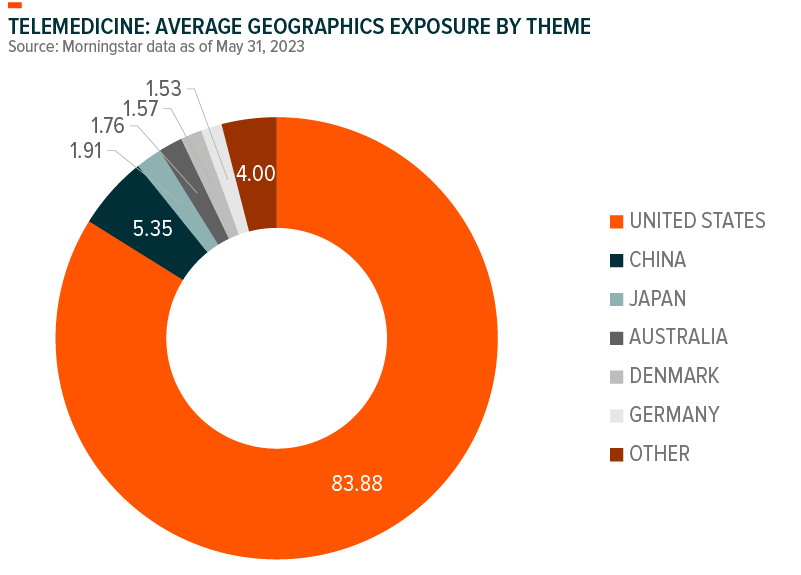
In our view, thematic equity should be targeted using screens to ensure that the underlying companies provide the desired exposure. This pure play focus minimizes overlap between themes, while also differentiating the exposure provided by the theme relative to broad beta products. We conducted an overlap analysis between Genomics and Telemedicine thematic ETFs, the S&P 500, MSCI ACWI, and the most applicable S&P 500 Sector ETF, the Healthcare Select Sector SPDR Fund (XLV).
We found that average overlap by weight for genomics-focused ETFs was 2.2% when compared to the S&P 500, 1.6% vs. the MSCI ACWI, and 6.5% vs. XLV.27 Common holdings included biotechnology, life sciences tools and services, pharmaceuticals, and laboratories. For Telemedicine-focused ETFs, the overlap was 0.7% when compared to the S&P 500, 0.5% vs. the MSCI ACWI, and 5.0% vs. XLV.28 These low levels of overlap with broad indexes reflect the benefits of thematic exposure.

The Healthcare Innovation theme is at the crossroads of multiple structural trends that are expected to increase adoption and investment in coming years. In Genomics, the potential benefits for personalized medicine and disease prevention are significant. In Telemedicine, expanding access can create stronger integrations between pharmacies, doctors, and patients. Together, these themes have the broader Healthcare Innovation theme poised for significant growth potential in the coming years, direct exposure to which could bring compelling opportunities to investor portfolios.
How to Access Healthcare Innovation
The graphic below identifies the largest U.S. listed ETFs that provide direct exposure to the Health Innovation theme through Genomics and Telemedicine.
